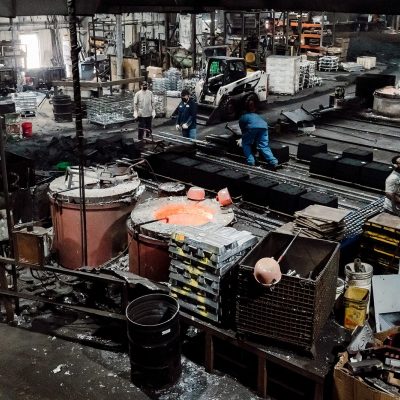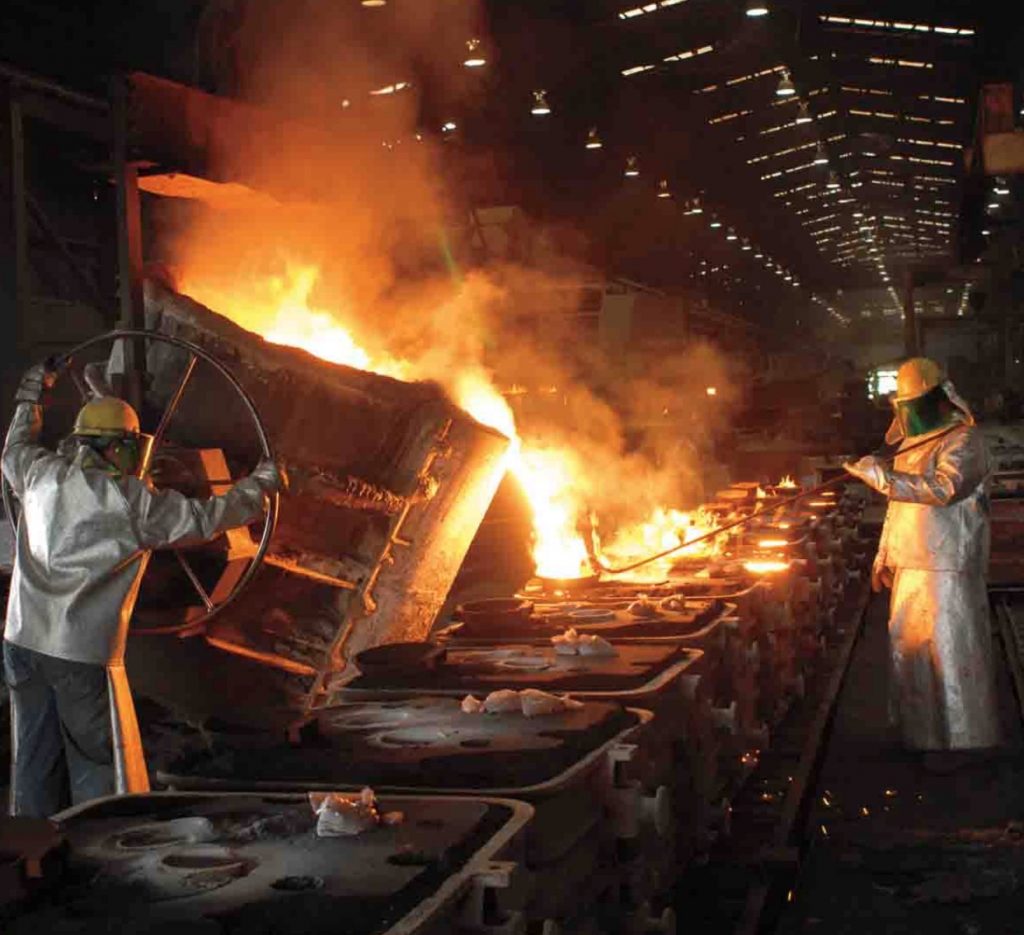Exploring innovative applications of Aluminum Castings in various fields
Wiki Article
Comprehending the Steel Castings Refine: A Comprehensive Overview for Beginners
The Metal Casting procedure is a fundamental method in manufacturing that changes molten metal right into solid types. Newbies must understand the various methods entailed, such as sand casting and die casting. Recognizing the products, layout principles, and precaution is just as vital. Each aspect plays an important role in accomplishing effective results. As one browses these ins and outs, the question of how to enhance each action for boosted outcomes ends up being significantly significant.The Basics of Metal Casting
Metal Casting has actually developed over centuries, its fundamental principles continue to be consistent and integral to the manufacturing process. At its core, Metal Casting entails the transformation of molten steel right into solid items with numerous techniques. The process starts with the production of a mold, which defines the form of the end product. Once the mold is prepared, metal is warmed to its melting factor and put into the tooth cavity. After cooling, the steel strengthens, taking the shape of the mold.There are a number of casting approaches, including sand spreading, financial investment spreading, and pass away casting, each with distinct advantages and applications. The choice of method relies on factors such as manufacturing volume, material type, and preferred precision. When cast, the final product might undergo additional procedures like machining or surface therapy to achieve the required surface and specifications. Recognizing these essentials is crucial for any individual curious about the area of Metal Casting.

Recognizing Products Utilized in Metal Casting
Products play an essential function in the Metal Casting procedure, affecting the final product's residential or commercial properties and efficiency. Different steels are utilized, including aluminum, iron, steel, and bronze, each offering unique qualities matched for certain applications. Light weight aluminum is light-weight and corrosion-resistant, making it optimal for vehicle components. Iron, particularly cast iron, is favored for its outstanding wear resistance and longevity. Steel offers high toughness and flexibility, usually used in hefty equipment parts. Bronze, recognized for its corrosion resistance and machinability, is commonly utilized in aquatic applications.Along with the steels, different casting products, such as sand, plaster, and ceramic, are used to produce mold and mildews. Sand casting, the most prevalent technique, utilizes silica sand due to its thermal stability and capacity to form complex forms. Plaster and ceramic molds supply finer information yet may call for even more complicated processes. The choice of materials straight influences the performance, expense, and high quality of the casting operation.
The Design Process: From Concept to Plan
The layout procedure in Metal Casting starts with the preliminary principle advancement, where ideas are generated and examined. This is followed by the application of CAD modeling techniques, enabling exact visualizations of the layout. Lastly, the blueprint finalization actions assure that all specifications are precisely documented for manufacturing.First Concept Advancement
Preliminary idea growth notes a critical phase in the Metal Casting procedure, where ideas transform into tangible designs. Throughout this phase, designers team up with designers and stakeholders to brainstorm and improve preliminary concepts. They consider variables such as performance, appearances, and manufacturability, making sure that the style fulfills the needed specifications and efficiency requirements. Illustrations and outlines are created to picture the concepts, permitting preliminary analyses of expediency and cost-effectiveness. This phase likewise entails determining materials and prospective casting approaches that align with the layout objectives. Ultimately, first concept growth prepares for a thorough plan, guiding the succeeding phases of the spreading process and making certain a successful change from idea to fact.CAD Modeling Techniques
Transforming ideas right into accurate designs, CAD modeling methods play an essential role in the Metal Casting procedure. These techniques utilize advanced software to create thorough three-dimensional versions that accurately reflect the intended item. By using tools such as parametric modeling, solid modeling, and surface modeling, developers can adjust measurements and shapes easily. CAD systems likewise promote simulation and evaluation, permitting the identification of prospective problems prior to manufacturing starts. This aggressive approach reduces material waste and optimizes the style for manufacturability. Furthermore, CAD designs can be quickly changed, making it possible for fast models based on feedback. Fundamentally, CAD modeling works as the backbone of the design process, bridging the gap in between initial concepts and the eventual production-ready layouts.Plan Completion Tips
Complying with the development of in-depth CAD designs, the next phase involves plan completion, which is critical in translating digital layouts right into actionable prepare for production. This process starts with assessing the CAD designs for accuracy and compliance with specifications. As soon as validated, the measurements, resistances, and product specs are carefully described to ensure clarity. Incorporating notes and notes assists communicate essential details relating to casting processes, surface area finishes, and setting up requirements. The finalized blueprint undertakes a strenuous authorization process, usually including cooperation with designers and production groups to attend to any type of potential problems. After all alterations are made and approvals obtained, the blueprint is formally released, functioning as the foundational document for the succeeding stages of Metal Casting, consisting of pattern making and mold and mildew design.The Metal Casting Strategies Described

Metal Casting methods include a range of techniques utilized to shape molten metal into wanted kinds. These strategies differ according to the sort of product, complexity of the style, and manufacturing volume. Sand spreading is among the most common approaches, entailing the production of a mold from sand to hold the molten metal. Financial investment spreading, or lost-wax spreading, enables Wisconsin Aluminum Foundry elaborate designs by utilizing a wax pattern that is dissolved. Die casting employs high-pressure injection of molten steel into a mold, ideal for automation. Other methods consist of irreversible mold casting, which makes use of recyclable molds, and centrifugal spreading, where rotational pressures assist in loading the mold and mildew. Each method has its advantages and applications, making it important for manufacturers to pick the ideal method based upon their details needs and demands. Understanding these techniques is important for any individual associated with the Metal Casting procedure.
Ending Up Processes: Enhancing Your Casted Product

Finishing processes play an important duty in improving the quality and look of casted products. Various surface area therapy methods, such as sprucing up and coating, are utilized to boost resilience and aesthetic appeals. Additionally, quality assessment techniques guarantee that the end product fulfills specified criteria and performance demands.
Surface Area Therapy Methods
A selection of surface therapy methods play an essential duty in improving the high quality and long life of casted items. These strategies include approaches such as shot blasting, brightening, and coating. Shot blowing up properly eliminates surface area flaws, improving the aesthetic and useful features of the casting. Sprucing up gives a smooth coating, which is especially crucial for ornamental applications and components needing minimal friction. Layer techniques, such as electroplating or powder coating, offer additional defense versus rust and wear, making certain longevity. Surface area treatments can improve bond for subsequent procedures, such as painting or bonding. By using these methods, manufacturers can accomplish premium surface area top quality, which is vital for the performance and lifespan of Metal Casting in numerous applications.High Quality Evaluation Approaches
Reliable top quality inspection approaches are necessary for assuring the integrity and performance of casted items after the ending up procedures. Numerous techniques are used to analyze the quality of Metal Casting, consisting of aesthetic evaluation, dimensional checks, and non-destructive screening (NDT) Aesthetic evaluation enables for the identification of surface defects, while dimensional checks guarantee that items meet defined tolerances. NDT methods, such as ultrasonic screening and radiographic assessment, offer deeper understandings right into inner honesty without harming the castings. Additionally, mechanical screening, such as tensile and solidity examinations, assesses product residential or commercial properties - Aluminum Castings. By employing a mix of these methods, suppliers can enhance item quality and integrity, ultimately causing higher consumer complete satisfaction and minimized production expensesSafety Considerations in Metal Casting
While the Metal Casting procedure offers countless advantages, it additionally provides a variety of safety and security dangers that need to be carefully handled. Workers in casting facilities are exposed to high temperature levels, liquified steels, and dangerous materials, which can result in extreme injuries if proper precautions are not taken. Personal safety tools (PPE) such as heat-resistant handwear covers, face guards, and safety apparel is crucial to minimize dangers.In addition, the existence of fumes and dirt demands proper ventilation systems to assure air high quality - Aluminum Castings. Normal training on security procedures is important for all employees to recognize potential hazards and respond effectively. Emergency situation treatments must be established, consisting of fire security steps and emergency treatment availability. Upkeep of devices and appropriate handling of products better contribute to a much safer working atmosphere. By focusing on these safety and security factors to consider, Metal Casting procedures can secure their labor force and keep reliable manufacturing processes
Often Asked Inquiries
What Are the Ecological Effects of Metal Casting?
Metal Casting can bring about environmental effects such as air and water pollution, resource exhaustion, and energy usage. In addition, improper waste administration and discharges from shops add to eco-friendly disruptions and wellness dangers for neighboring areas.How Do I Choose the Right Steel for Casting?
To choose the appropriate metal for spreading, one should think about aspects such as mechanical residential properties, deterioration resistance, thermal conductivity, and expense. Assessing the desired application and environmental conditions is essential for excellent selection.What Are the Common Defects in Metal Casting?
Typical defects in Metal Casting include porosity, shrinkage, sand inclusion, and misruns. These issues often arise from improper material option, insufficient design, or flaws in the spreading process, impacting the end product's quality and performance.
Just How Can I Boost My Metal Casting Abilities?
To boost Metal Casting abilities, one need to exercise continually, research casting techniques, analyze previous tasks for problems, look for feedback from experienced casters, and constantly trying out different products and techniques to boost efficiency and understanding.What Is the Price of Beginning a Steel Casting Business?
Starting a steel casting company normally needs an initial financial investment of $5,000 to $50,000, depending on devices, products, and facility prices. Elements like place and range can substantially influence general startup expenses.The Metal Casting process is an essential strategy in producing that transforms molten metal right into solid forms. Beginners must grasp the different approaches involved, such as sand spreading and die spreading. There are several casting methods, including sand casting, investment spreading, and die casting, each with distinct advantages and applications. Investment spreading, or lost-wax spreading, enables for intricate layouts by using a wax pattern that is thawed away. Other approaches consist of permanent mold spreading, which utilizes reusable mold and mildews, and centrifugal casting, where rotational pressures help in loading the mold and mildew.
Report this wiki page